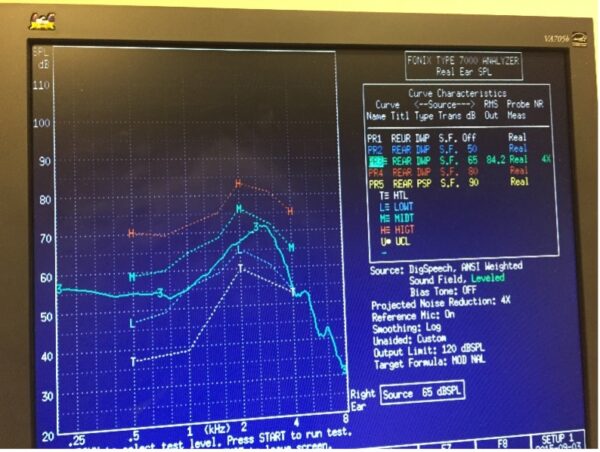Real Ear Measurement
Real-Ear Measurement—Because Every Ear is Unique.
Believe it or not, the size and shape of an individual’s external ear and ear canal plays a role in the fitting of a hearing aid. This is because the size and shape of the ear canal affects the acoustics and resonant qualities of the ear!
Real Ear Measurements
Dr. Linn explains Real Ear Measurements. The Gold-Standard of Hearing Aid fitting.
Real ear measurements help us adjust your hearing aids to ensure optimal performance.
The gold-standard of hearing aid fitting includes real-ear measurement, also known as ‘probe-microphone measurement.’ This technique allows us to measure what the hearing aid is delivering to the eardrum, taking into account the acoustic properties of the ear canal. Without performing this measurement, there is no way to know whether a hearing aid is providing the appropriate amplification across the important speech frequencies at various loudness levels to correct the hearing loss.

Why risk spending thousands of dollars on hearing aids that may not be programmed to the best of its ability?
Below, in Figure 1, is an example of real-ear measurement showing a poorly fit hearing aid; in fact, the fitting shown is typically referred to as a ‘first fit’, i.e., the programming that is measured when the hearing aid is first programmed before fitting it into the patient’s ear. The ‘first fit’ is a starting point, not the final programming point.
The dotted green ‘M’ curve and the solid green curve do not match up on the ‘first fit’; they should match if the patient will be able to regain full audibility of sound. An individual fit with a hearing aid like this would likely say that “sounds are louder, but still not clear”.
This individual’s hearing aids are not providing sufficient amplification in the high-frequencies and need to be adjusted beyond the ‘first fit’.

In Figure 2, we see what can be accomplished through a few seconds of programming the hearing aid’s signal processing and how the green curves now match more fully which indicates we have achieved the projected target gain necessary for this patient to hear average conversational loudness.

In Figure 3, we simply complete the programming of the hearing aid for a soft input and loud input signal as well as checking the saturation level of the hearing aid with a very loud input signal and now the hearing aid is programmed to the patient’s hearing loss requirements. This is objective evidence that the hearing aid is performing the way it should be for the individual’s hearing loss and unique ear acoustics. This is the starting point for the patient to leave the office and start using the hearing aids in their everyday listening situations. After a week or so, the patient will return for further programming and fine-tuning of the prescription based on their subjective input and further real-ear testing.

Customization creates clearer, better hearing: that’s why it’s the gold-standard.
Real-ear measurements using probe-microphone equipment is a best-practices requirement if hearing aids are to be fit accurately and individually to each patient and each ear.
Even within the same patient, each ear has to be evaluated to ensure appropriate prescriptions for hearing loss are addressed. Hearing aids should not be worn without the use of real-ear measurements as the gold-standard method to ensure soft and average sounds are made clear and loud sounds are controlled within the patient’s individual tolerance to loud sounds.
Although real-ear measures are used to ensure the hearing aids are programmed correctly, it still takes time for the brain to acclimate or get used to the amplified sound. One side effect of wearing hearing aids is hearing! Your audiologist will ensure that the programmed fitting you start with is tolerable for your everyday listening situations and your audiologist will work with you during your accommodation period to address your observations of sound while wearing the aids.
Do you need Real-Ear Measurement to make the most of your hearing aids?







